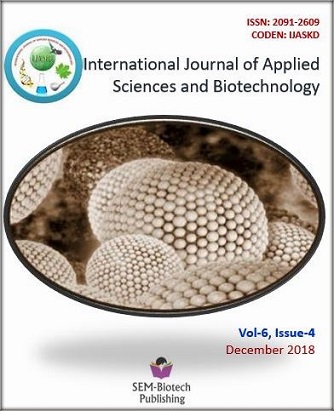Computational Biology Approach for Deciphering Etiological Pathway of Polygenic Diseases: Rheumatoid Arthritis
DOI:
https://doi.org/10.3126/ijasbt.v6i4.22111Abstract
Rheumatoid Arthritis (RA) (OMIM ID: 180300) is an inflammatory autoimmune disease caused by immune reaction against the proliferating synovial fibroblasts. Nonsuppurative proliferation of synoviocytes frequently progresses to destroy the articular cartilages and underlying bone, resulting in permanent disability. Using system biology approach, candidate genes obtained from OMIM (Online Mendelian Inheritance in Man) and its interacting proteins were prioritized on the basis of three Gene Ontology terms (Molecular Function, Cellular component, and Biological Process) employing FunSimMat (Functional Similarity Matrix). Among the many, four prioritized proteins NFκBIL1, HCST, MICA, and MICB were selected. Amongst the prioritized genes, literature review suggested that NFκBIL-1 (Nuclear Factor-κ of B-cell Inhibitor Like protein-1) (UniProtKB ID: Q9UBC1) competes against SR (Ser-Arg) protein, ASF/SF2, in negatively regulating CD45RO gene expression in CD4 T-cells, whose overproduction would lead to cytokine outburst, thus leading to an immunological attack. ASF/SF2 mediated splicing variant, CD45RA, otherwise would have prevented overproduction of these cytokines. Overproduced cytokines such as TNF-α, IL-6, IL-15 simultaneously induces inflammatory stress in the synovial membrane and activates stress induced MICA/B (UniProtKB ID: Q29983/Q29980) through downstream signaling following TNFR1-TRAF mediated signaling pathway. Synovial expression of MICA/B enables interaction with its ligand NKG2D associated with DAP10 (UniProt KB ID: Q9UBK5) amply present on CD8+ αβ T-cells, CD4+γδ T-cells, and NK cells, thus promoting cytolysis of MICA/B expressing synoviocytes along with further production of cytokines TNF-α and IL-15. Hence, alteration in NFκBIL-1 promoter induces MICA/B expression that leads in production of cytokines could be a probable cause of chronic RA.
Int. J. Appl. Sci. Biotechnol. Vol 6(4): 332--338




